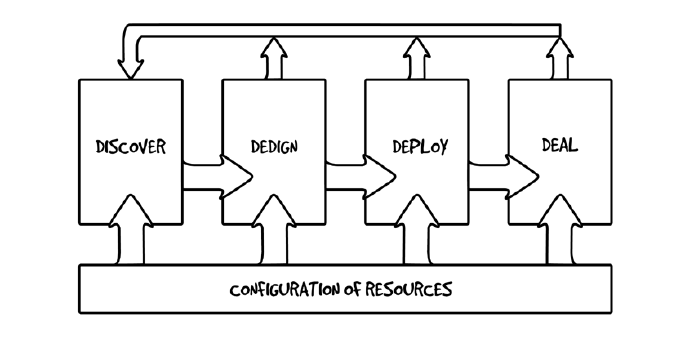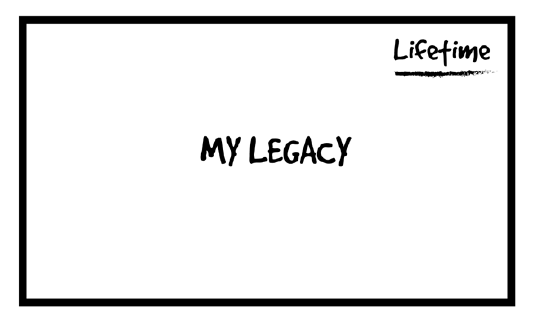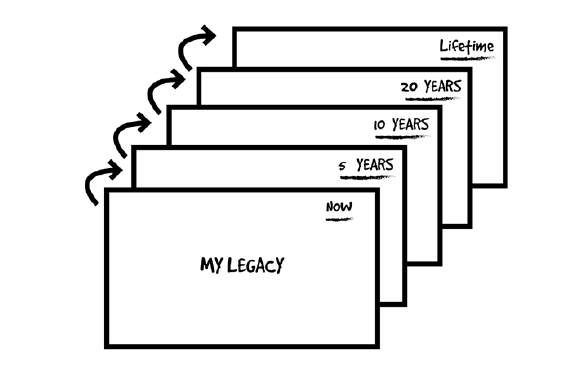<< Previous Next >>
The execution
Blockbuster: Behind The Scenes
“4D Framework: Execution Is Everything”
Building a personal brand is always a journey and not just a destination. So, treat it like a “work in progress.” You are either growing or shrinking. There is no middle ground.
What could you do on a weekly basis to contribute towards your brand? What investments can you make to yourself so that you can see measurable progress in reasonable time? As a technology professional, there are many areas where you can focus on to start this journey.
Here is a four-part model for the personal brand journey:
Now, let’s go over each of these four stages in a briefly at first and then in more detail soon after:
Discover
The two questions to ask here are
#1. How do you want to be remembered long after you are gone?
AND
#2. Are you willing to give everything to make this vision a reality?
Design
A personal brand needs to be thoughtfully designed. The first thing to remember is that your lifetime is the time horizon for this exercise. Think how your experience, your current network and your current strengths could be leveraged to build a powerful persona over the coming years. What could you be known for? How could each of your accomplishments during the next year contribute to this personality?
Deploy
Personal brand building is not a solo sport! How can others see, touch and feel your brand? Could you publish articles in relevant industry journals? Can you speak at conferences? Can you start a blog on your topic of expertise and draw attention? At which “exclusive clubs” can you play a prominent role to get your name out?
Deal
In this part of the journey, you must “walk the talk” and live up to your brand promise. Nothing is worse than making a promise and not living up to it.
While it appears that these stages are sequential, we often experience the process differently in real life. We sometimes return to earlier stages, refine our personal brands, and then proceed forward again. As you can see clearly from the framework, building your personal brand will be a significant project. It’s a project that you won’t be able to complete alone. You will need help from others.
Here are a few important things to remember about help:
- It is easier to get help when you don’t need it than when you need it immediately.
- It is also easy to get help from people whom you have already helped before than to get help from strangers and casual acquaintances.
- It is easy to get help when people know that you need help and are open to receive help from them.
The Configuration
We all (hopefully) have people around us who can help us, just like we can help people around us. Imagine you and the people around you are each pieces in a giant set of Lego blocks. You can configure these pieces (your resources) into many different shapes. Just like you will have a set of Lego blocks (resources) at your disposal, you yourself will be a Lego block (resource) in many other people’s lives. Here’s your challenge. During each stage of your personal-branding journey, configure all your available resources in the most optimum fashion. Help others configure their resources effectively too.
The Catalyst: Relevance at Every Interaction
You are always communicating, even when you are silent. Think about it. Let’s say that you lock yourself away in a room far from everyone that you know. Even then, you are still communicating. You’ve signaled to people that you don’t want to be around anyone.
So, if you want to build connections with people, you should develop your communication skills.
Relevance plays a key role in making your communications powerful. If you strive, in every interaction, to be relevant to the people that you are communicating with, then people will be eager to continue their conversations with you. Relevance acts as a true catalyst. Once people are open to receive communication with you, it will become easier for you to build your personal brand!
Now, let us go over the stages in a bit more detail:
Stage One: The Plot
“Discover”
When it comes to personal branding, no discussion is complete without talking about authenticity. If your brand does not represent who you really are, then you will have a tough time wearing masks for the rest of your life. On the other hand, if your personal brand is a true representation of “who you really are” it simplifies your life. It is therefore important to discover your true self, your strengths, and your passion.
Here are a few questions to consider:
What do you want your legacy to be? What do you want to be remembered for?
———————————————————————————
———————————————————————————
This particular question is extremely important. Why? Simply because you may not have a solid idea of what your legacy should be. It evolves as you learn and grow.
Even when you know that this might change, it is still better to have something there. After that, you have to use the “staircase to heaven” approach to determine how you will go from your “current personal brand” to your “lifetime legacy”.
You have to evolve your personal brand over the next few decades to finally arrive at your legacy. As you grow, you can revise and revisit the “staircase to heaven” to fit the new goal.
What are you passionate about?
———————————————————————————
———————————————————————————
What experience do you think will be valuable to the marketplace?
———————————————————————————
———————————————————————————
Where can you establish thought leadership?
———————————————————————————
———————————————————————————
Would you behave differently if you treated yourself like a business—“You Inc.”?
———————————————————————————
———————————————————————————
Thinking as if you were a company “You Inc.” will help you during the design phase. In order to be successful, a company needs positioning, marketing, sales, delivery and service ( just to name a few functions). Your design should ensure that you are taking care of all these items for yourself.
Stage Two: The Set
“Design”
Once you discover who you are and what your brand should portray, the next step is to design an execution plan to make it a reality. If you are starting out on your personal branding journey, my suggestion would be to find your distinctive space. In other words, determine your ideal audience.
You can discover more about your audience by answering these questions
Who will find you and your unique strengths valuable in the marketplace?
———————————————————————————
———————————————————————————
How much do you know about your audience?
———————————————————————————
———————————————————————————
What is your audience reading?
———————————————————————————
———————————————————————————
What clubs do they belong to?
———————————————————————————
———————————————————————————
Where do they live?
———————————————————————————
———————————————————————————
What are they worried about?
———————————————————————————
———————————————————————————
Who influences them?
———————————————————————————
———————————————————————————
It is common sense that it is easy to solve somebody else’s problem rather than your own. When it comes to designing a plan for your personal brand, I follow the same approach. Think of this as a project you are doing it for your client. In this case, you are your own client. The project is to build a personal brand for the client.
Start by answering these questions:
How would you approach this personal branding project if you were executing it for one of your clients?
———————————————————————————
———————————————————————————
What kind of preparation would you make before you begin the client’s project?
———————————————————————————
———————————————————————————
What kind of resources would you need?
———————————————————————————
———————————————————————————
What team would you have during each stage of the project?
———————————————————————————
———————————————————————————
What are the key milestones?
———————————————————————————
———————————————————————————
How would you measure your success?
———————————————————————————
———————————————————————————
Imagine a very large software project. You don’t think you can execute on it successfully with one person. Often, these projects require a whole team with a diverse set of skills and experience. It is the same case here for the personal branding project. Try to partner with a team of people on your personal branding project. Approach this as if it is one of the biggest projects of your lifetime. It will be!
Stage Three: Lights, Camera, Action!
“ Deploy”
Silicon Valley, where I live, is a very interesting place. It is filled with people who constantly generate fresh ideas. Sometimes, when I meet young entrepreneurs, they offer fascinating insights into recent announcements made by leading companies. Here are some examples of comments I have heard from young and aspiring entrepreneurs:
“I knew this was coming. It was an obvious thing to do.”
“I had the same idea a few years ago. I just didn’t act on it.”
“I have a better idea than that. I don’t know why they don’t see it. If given a chance, I can do better than that.”
“I know what they are going to do next. I have been right the last few times, and I know I will be right this time, too.”
We all have plans. Ideas, on their own, have no great value unless you act on them. Personal branding is really no different. The grandest plans will make no difference if you don’t take actions to make them a reality.
You will spend a great deal of time in the Deploy phase, but you will never truly complete it. You will always be deploying your personal brand. This is where the biggest difference between a traditional project and a personal-branding project. You must continue to find a venue for your voice and express yourself.
Here is a partial list of venues and some ideas on how you can leverage them:
Whitepapers
Can you write a whitepaper that provides a unique perspective on an important problem faced by your target audience?
Do you have a solution to a burning problem faced by your target audience and can you put that solution in the form of a whitepaper?
Websites
What websites do the people in your target audience visit?
What can you contribute to these websites that others are not already contributing?
If you are not ready to contribute yet, can you enhance the contributions of others by leaving valuable comments on their articles or linking to these articles via your blog?
Blogs
Can you start a blog AND maintain it with quality content for the next five years?
If you can, why have you not started a blog yet?
If you can’t, what should you do in the next one or two years that will take you there?
Can you start enhancing the conversations over at other blogs by providing quality comments?
Magazines and Newspapers
How can you be a resource to journalists as an expert on the topic where you are already a thought leader or want to establish your thought leadership?
What steps can you take to build relationships with these journalists?
Have you considered investing in services like PRLeads and “Help a Reporter Out” (HARO)? These services aggregate requests by reporters who are looking for help from experts to complete their stories.
Clubs and Professional Organizations in your “space”
What clubs and professional organizations do members of your target audience belong to?
Some of these clubs are exclusive. Who among your friends can get you into them as a member?
Do you have the credibility to speak on a topic of interest to your target audience at one or more of these venues? If yes, what steps can you take to orchestrate that?
What role can you play in these organizations (voluntary or paid) to contribute in a meaningful way?
Networking Groups like SIGs (Special Interest Groups)
Special Interest Groups bring together like-minded people and typically meet once in a month. Since they are usually run by a non-profit, they are always looking for help. What help can you provide them?
What can you do that is valuable but others don’t see it that way? Take for example, picking up a keynote speaker from the airport. Most people consider this as the job of a car driver. The other way to look at it is to see it as an opportunity to get 1-1 time with the keynote speaker. Which way will you look at this?
Conferences-where you can speak or be on a panel
To get a speaking slot right away may be hard. Can you think of helping the organizers to find one or more speakers or maybe the whole panel? Imagine the possibilities of networking…
Non-profit Organizations
What are some of the non-profits that members of your target audience support?
These and all other non-profits are always looking for money. Is there a way you can help them with their fundraising?
Books: Traditional Books or e-books
What book can you write or contribute to that your target audience is reading?
Before that, how can you build credibility so that you are QUALIFIED to contribute to those books?
Newsletters
What newsletters are your target audience subscribing to?
Do you have compelling content that you can provide or syndicate to these newsletters?
How can you work towards creating your own newsletter that your target audience will subscribe in a heartbeat?
Whatever venue you choose, be sure to add value by offering new insights and providing thought leadership.
Stage Four: It’s Showtime!
“ Deal”
Last but not least, you need to deal with the consequences of building your brand. Usually the consequences are quite positive. However, you also have a responsibility to your brand. You must live up to the promise made by your brand.
At first, it might seem simple to live up to the promise of your brand. However, you will face difficulties in the following situations:
You made the wrong promise in the first place.
You don’t have the capacity to fulfill the promise.
You don’t have the capacity to build on your success–leading to eventual failure.
You will quickly lose credibility if your brand is not authentic to who you really are. If you succeed with some marketing gimmicks to establish a brand that is not authentic, it will be hard to live up to the promise, and people will see through it quickly. That in turn, will cause you to lose credibility. If you can’t live up to your brand promise a few times, your brand will start to disintegrate.
If you have had difficulties with authenticity and follow-through, start thinking about how you hold yourself accountable for small promises that you make.
Do you keep promises that you make to yourself?
Do you keep promises to people around you–family members and friends?
Once you develop consistency in this part of your life, you can improve your ability to keep the promises that you make to the world.
<< Previous Next >>



